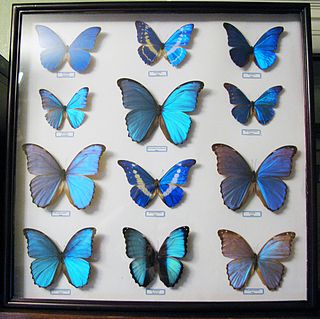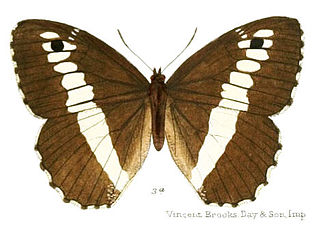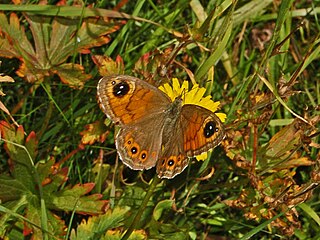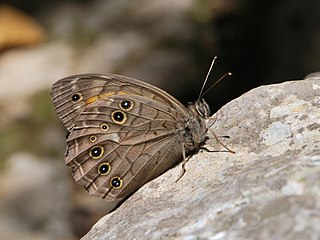
The Satyrinae, the satyrines or satyrids, commonly known as the browns, are a subfamily of the Nymphalidae. They were formerly considered a distinct family, Satyridae. This group contains nearly half of the known diversity of brush-footed butterflies. The true number of the Satyrinae species is estimated to exceed 2,400.

The Satyrini is one of the tribes of the subfamily Satyrinae. It includes about 2200 species and is therefore the largest tribe in the subfamily which comprises 2500 species.

The Morphinae are a subfamily of Nymphalidae butterflies that includes the morphos, the owl butterflies (Caligo), and related lineages. It is either considered a sister group of the Satyrinae, or disassembled and included therein.

Ypthima asterope, the African ringlet or common three-ring, is a species of Satyrinae butterfly found in most dry areas of Africa and Asia.

Ypthima ceylonica, the white fourring, is a species of Satyrinae butterfly found in Sri Lanka and India.

The Elymniini is one of the tribes of the subfamily Satyrinae. If the subfamily Satyrinae elevate to family status, this tribe shall be treated as subfamily Elymniinae. Elymniini was formerly a large group, but recently, it is considered to be include only one genus, Elymnias, according to molecular phylogenetic analyses.

The butterfly subtribe Euptychiina is a diverse group within the tribe Satyrini, occurring throughout Central and South America, in addition to a few species known from North America. Euptychiina is a predominantly lowland group, with the exception of one Asian taxon Palaeonympha opalinaButler, 1871 and the Andean genus ForsterinariaGray, 1973. The taxon was erected by Lee Denmar Miller.

Aulocera is a genus in the subfamily Satyrinae of the brush-footed butterfly family, Nymphalidae. Commonly referred to as banded satyrs, species of the genus Aulocera are endemic to the Himalayas and associated mountain ranges.

Pseudochazara is a genus of butterflies within the family Nymphalidae.

Lasiommata is a genus of butterflies of the subfamily Satyrinae in the family Nymphalidae.

Lepidoptera Indica was a 10 volume work on the butterflies of the Indian region that was begun in 1890 and completed in 1913. It was published by Lovell Reeve and Co. of London. It has been considered the magnum opus of its author, Frederic Moore, assistant curator at the museum of the East India Company. Frederic Moore described a number of new species through this publication. Moore was a splitter, known for careless creation of synonyms, sometimes placing the same species in more than one genus.

Kirinia is a genus of butterflies of the family Nymphalidae found in Europe and Asia.

Pseudochazara baldiva is a butterfly species belonging to the family Nymphalidae described by Frederic Moore in 1865. It can be found in the Himalayas, Kashmir, Tibet and India.

Lethe chandica, the angled red forester, is a species of Satyrinae butterfly found in the Indomalayan realm.

Lethe bhairava , the rusty forester, is a species of Satyrinae butterfly found in the Indomalayan realm

Lethe baladeva, the treble silverstripe, is a Satyrinae butterfly found in the Indomalayan realm. The species was first described by Frederic Moore in 1866.

Ypthima watsoni, the looped three-ring, is a species of Satyrinae butterfly.

Ethope is a butterfly genus from the subfamily Satyrinae in the family Nymphalidae. The genus was erected by Frederic Moore in 1866.



















